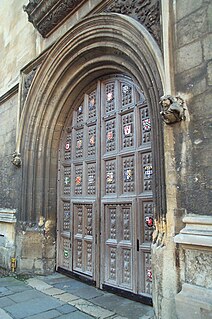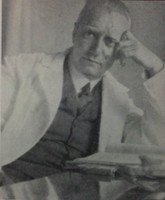| Rabbi Chaim Michael Dov Weissmandl | |
|---|---|
 Weissmandl before the war | |
| Position | Rosh Yeshiva |
| Yeshiva | Nitra Yeshiva, Mount Kisco, New York |
| Began | 1946 |
| Ended | 29 November 1957 |
| Personal details | |
| Birth name | Chaim Michael Dov Weissmandl |
| Born | 25 October 1903 Debrecen, Hungary |
| Died | 29 November 1957 (aged 54) Mount Kisco, New York |
| Denomination | Orthodox |
| Parents | Yosef and Gella Weissmandl |
| Spouse |
|
| Part of a series of articles on the Holocaust |
| Blood for goods |
|---|
 |
Writers
|
Chaim Michael Dov Weissmandl (also known as known as Michael Ber Weissmandl; 25 October 1903 – 29 November 1957) was a rabbi and shtadlan who became known for his efforts to save the Jews of Slovakia from extermination at the hands of the Nazis during the Holocaust. Thanks to the efforts of his "Working Group", which bribed German and Slovak officials, the mass deportation of Slovak Jews was delayed for two years, from 1942 to 1944.
In Judaism, a rabbi is a teacher of Torah. The basic form of the rabbi developed in the Pharisaic and Talmudic era, when learned teachers assembled to codify Judaism's written and oral laws. The first sage for whom the Mishnah uses the title of rabbi was Yohanan ben Zakkai, active in the early-to-mid first century CE. In more recent centuries, the duties of a rabbi became increasingly influenced by the duties of the Protestant Christian minister, hence the title "pulpit rabbis", and in 19th-century Germany and the United States rabbinic activities including sermons, pastoral counseling, and representing the community to the outside, all increased in importance.
A shtadlan was an intercessor for a local European Jewish community. They represented the interests of the community, especially those of a town's ghetto, and worked as a "lobbyist" negotiating with the authorities holding power for the safety and benefit of Jews. The process of Jewish intercession is known as shtadlanus.

Slovakia, officially the Slovak Republic, is a landlocked country in Central Europe. It is bordered by Poland to the north, Ukraine to the east, Hungary to the south, Austria to the west, and the Czech Republic to the northwest. Slovakia's territory spans about 49,000 square kilometres (19,000 sq mi) and is mostly mountainous. The population is over 5.4 million and consists mostly of Slovaks. The capital and largest city is Bratislava, and the second largest city is Košice. The official language is Slovak.
Contents
- Early life
- World War II and the Holocaust
- The Working Group
- Deportation
- Post-war America
- Personal recovery
- An innovative American yeshiva
- Later life
- Religious work
- Statements
- Books
- References
- Sources
- External links
Largely by bribing diplomats, Weissmandl was able to smuggle letters or telegrams to people he hoped would help save the Jews of Europe, alerting them to the progressive Nazi destruction of European Jewry. It is known that he managed to send letters to Winston Churchill and Franklin D. Roosevelt, and he entrusted a diplomat to deliver a letter to the Vatican for Pope Pius XII.

Sir Winston Leonard Spencer-Churchill, was a British politician, army officer, and writer. He was Prime Minister of the United Kingdom from 1940 to 1945, when he led Britain to victory in the Second World War, and again from 1951 to 1955. Churchill represented five constituencies during his career as a Member of Parliament (MP). Ideologically an economic liberal and imperialist, for most of his career he was a member of the Conservative Party, which he led from 1940 to 1955, but from 1904 to 1924 was instead a member of the Liberal Party.

Franklin Delano Roosevelt, often referred to by his initials FDR, was an American statesman and political leader who served as the 32nd president of the United States from 1933 until his death in 1945. A Democrat, he won a record four presidential elections and became a central figure in world events during the first half of the 20th century. Roosevelt directed the federal government during most of the Great Depression, implementing his New Deal domestic agenda in response to the worst economic crisis in U.S. history. As a dominant leader of his party, he built the New Deal Coalition, which realigned American politics into the Fifth Party System and defined American liberalism throughout the middle third of the 20th century. His third and fourth terms were dominated by World War II. Roosevelt is widely considered to be one of the most important figures in American history, as well as among the most influential figures of the 20th century. Though he has also been subject to much criticism, he is generally rated by scholars as one of the three greatest U.S. presidents, along with George Washington and Abraham Lincoln.

Pope Pius XII, born Eugenio Maria Giuseppe Giovanni Pacelli, was head of the Catholic Church from 2 March 1939 to his death. Before his election to the papacy, he served as secretary of the Department of Extraordinary Ecclesiastical Affairs, papal nuncio to Germany, and Cardinal Secretary of State, in which capacity he worked to conclude treaties with European and Latin American nations, most notably the Reichskonkordat with Nazi Germany.
He also begged the Allies to bomb the rails leading to Auschwitz, but to no avail. He believed that if the Hungarian Jews would resist, then only a small number of them would be deported, as the Germans in 1944 could not garner enough soldiers to leave the front and deal with the Jews simultaneously. Of around 900,000 Hungarian-speaking Jews, close to 600,000 were murdered. [1]

The Allies of World War II, called the United Nations from the 1 January 1942 declaration, were the countries that together opposed the Axis powers during the Second World War (1939–1945). The Allies promoted the alliance as a means to control German, Japanese and Italian aggression.

The issue of why Auschwitz concentration camp was not bombed by the Allies during World War II continues to be explored by historians.

















